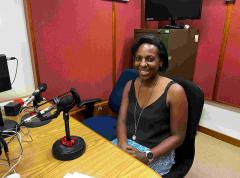简介
Listen to #Hashtag Hong Kong every Sunday morning at 8.15
Focussing on issues affecting civil society, we'll hear from representatives of NGOs, associations, statutory bodies, and non-profit groups.
(Sundays 8.15am - 8.25am)
最新

Dr. Chris Yiu - Director of the SLCO Community Resources
Good morning. A movie titled "The Way We Talk" has brought people's attention to the needs of the local deaf community in Hong Kong. SLCO had begun supporting its production ten years ago. This is a first ever movie that has invited a large group of deaf people participating in the production, including its pre-production research, sign language training and supervision, and actors. It has reflected a wide range of genuine life experience of deaf people.
What makes "The Way We Talk" so touching to me is that the three main characters, despite their different upbringings, attitudes, choices, and pathways, come to respect and acceptance with each other, and become close friends. This concept of 'harmony in diversity' and inclusiveness is indeed rarely observed but invaluable in contemporary society.
However, throughout history, there have been many disputes and debates within the deaf community regarding sign language versus spoken language in education. These disagreements have led to significant divisions and even opposition among deaf people-It seems like a deaf person can either speak or sign.
I vividly remember a deaf student of mine who grew up with no sign language cried to me when he noticed that I was dedicated to re-introduce sign language learning in deaf education. Just like some parents and professionals, the student was strongly against sign language and believed that sign language learning would make deaf people dumb and consequently take away their opportunities to be ‘normal'. He attributed this as a betrayal of oral education that he wholeheartedly believed.
On the other hand, some deaf people using sign language feel that they were looked down upon by teachers when they were students because they could not speak well, while those who spoke well were always given a higher status in schools.
There is a long-standing misconception that no sign language learning should be given to deaf children with hearing aids or cochlear implants, but in fact, hearing instruments cannot bring normal hearing back to deaf people. Learning one more language, no matter if it is a sign or spoken language, can be a necessity or simply a personal choice for deaf people.The two languages are not mutually exclusive. It is their right to choose a language that suits them best, not to mention that sign language is the only language with no barriers to deaf people.
The scene in the movie that left the deepest impression on me is when Wolf suddenly realized that he would never been eligible to obtain a diving coach license just because he cannot hear. His emotional reaction was heartbreaking but also painfully real.
Speaking and hearing ability is just a small part of a person, yet society's biased view has neglected the potential of deaf people who rely on sign language and taken away their many opportunities to excel themselves. Suppressing this group of deaf people pushes them to the margins and leaves them isolated from society and even their families.
Self identity has always been a significant life challenge for many deaf people: Who am I? Am I deaf, hearing, or neither? Sadly,there have been deaf students of mine experienced severe emotional distress or even committed suicide because they were marginalized in the
society. They could not find their place in schools and families, to an extent that they continually rejected their own value and could not find reasons to love themselves.
Research tells us people with a bilingual bicultural identity possess a more positive self esteem since they do not have to force themselves to be a ‘normal' person or else a ‘person with disability’. The bilingual identity allows them to immerse themselves in both the deaf and hearing community and enjoy the friendships with both groups of persons with no restrictions. With this regard, the more sign bilingual talents we cultivate,the more communication bridges that are built to connect the deaf and hearing worlds.
重温





















